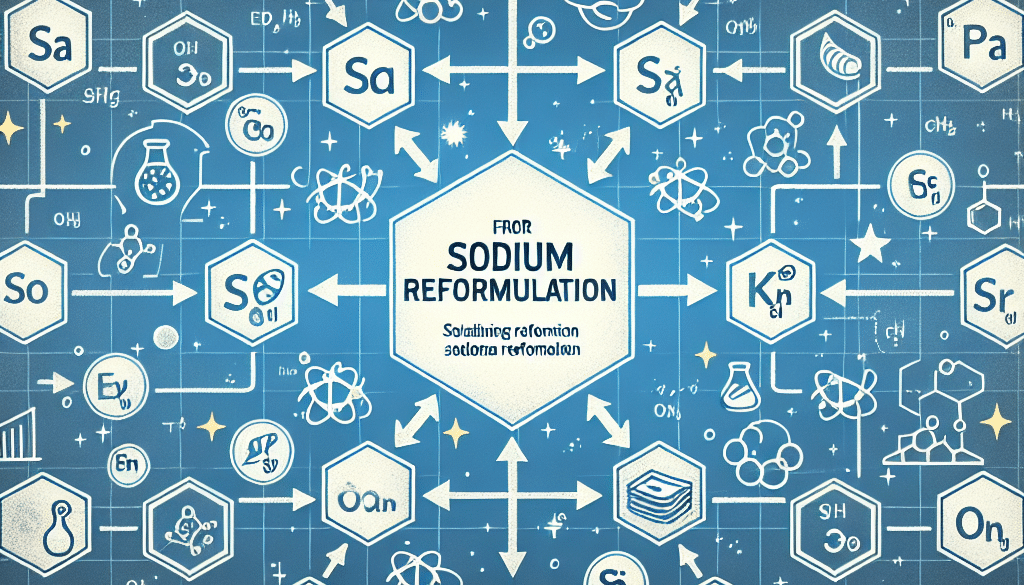Sodium Reformulation: Challenges and Opportunities in the Industry
-
Table of Contents
- Sodium Reformulation in the Food Industry: Balancing Health and Taste
- Understanding the Sodium Dilemma
- Challenges in Sodium Reduction
- Opportunities for Innovation
- Strategies for Sodium Reduction
- Case Studies and Success Stories
- Statistics and Research on Sodium Reduction
- Conclusion: The Future of Sodium Reformulation
- ETprotein: Your Partner in Health-Conscious Food Innovation
Sodium Reformulation in the Food Industry: Balancing Health and Taste

The global food industry is facing a significant challenge: reducing sodium content in food products without compromising taste or quality. Sodium reformulation is not just a trend; it’s a public health imperative. High sodium intake is linked to hypertension, heart disease, and stroke, prompting governments and health organizations to push for lower sodium levels in processed foods. This article explores the challenges and opportunities associated with sodium reformulation in the food industry.
Understanding the Sodium Dilemma
Before delving into the intricacies of sodium reduction, it’s essential to understand why it’s a concern. Sodium chloride, commonly known as table salt, is the primary source of sodium in our diets. While it’s necessary for bodily functions, excessive consumption can lead to health issues. Processed and packaged foods are the main culprits of high sodium content, often used to enhance flavor, preserve food, and improve texture.
Challenges in Sodium Reduction
Reducing sodium in food products is not without its challenges. Here are some of the main obstacles that the industry faces:
- Consumer Taste Preferences: Salt is a key flavor enhancer, and consumers have grown accustomed to the taste of high-sodium foods. Achieving the same taste profile with less salt is a significant hurdle.
- Food Safety and Preservation: Sodium plays a crucial role in preserving food by inhibiting the growth of bacteria. Finding alternative preservatives that are as effective as salt is challenging.
- Technical and Functional Issues: Salt contributes to the texture and mouthfeel of products. Replicating these properties with reduced sodium can be technically complex.
- Cost Implications: Research and development of low-sodium alternatives can be costly, and the use of new ingredients may increase production expenses.
Opportunities for Innovation
Despite the challenges, sodium reformulation presents opportunities for innovation in the food industry:
- Health-Conscious Consumer Base: There is a growing market for healthier food options, and companies that can successfully reduce sodium have a competitive edge.
- Technological Advances: New food processing technologies and flavor enhancers can help maintain taste while reducing sodium content.
- Regulatory Support: Governments are increasingly supporting sodium reduction initiatives, which can lead to incentives for compliant companies.
- Corporate Responsibility: Companies have the opportunity to lead in public health by proactively reducing sodium in their products.
Strategies for Sodium Reduction
Several strategies can be employed to reduce sodium content in food products:
- Gradual Reduction: Slowly lowering sodium levels over time can help consumers adapt to the taste of less salty foods without a noticeable difference.
- Alternative Salts: Using salts with lower sodium content, such as potassium chloride, can help maintain flavor while reducing sodium levels.
- Flavor Enhancers: Natural flavor enhancers and spices can help compensate for the reduced saltiness.
- Ingredient Substitution: Replacing high-sodium ingredients with lower-sodium alternatives is another effective approach.
Case Studies and Success Stories
Several companies have successfully reduced sodium in their products. For example, a leading soup manufacturer managed to cut sodium by 20% without affecting sales by gradually reducing salt content over several years. Another success story comes from a snack company that introduced a line of low-sodium chips using a blend of spices to maintain flavor.
Statistics and Research on Sodium Reduction
Research indicates that a significant reduction in dietary sodium could prevent tens of thousands of deaths annually from cardiovascular diseases. According to the World Health Organization, reducing sodium intake to recommended levels could save 2.5 million lives every year.
Conclusion: The Future of Sodium Reformulation
The journey towards sodium reformulation is complex but necessary. The food industry must continue to innovate and invest in research to find viable solutions that protect public health without sacrificing taste or quality. As consumers become more health-conscious, the demand for low-sodium products will likely increase, offering growth opportunities for forward-thinking companies.
ETprotein: Your Partner in Health-Conscious Food Innovation
As the food industry navigates the challenges of sodium reformulation, protein-rich ingredients from ETprotein can play a vital role in developing healthier products. ETprotein’s range of organic bulk vegan proteins, including rice, pea, and seed-based proteins, offer a neutral taste and allergen-free options that can enhance the nutritional profile of food products while supporting sodium reduction efforts.
ETprotein’s commitment to quality and innovation makes them an ideal partner for companies looking to reformulate products with reduced sodium content. Their expertise in protein manufacturing and supply can help businesses meet the growing demand for healthier food options without compromising on taste or texture.
For more information on how ETprotein can support your sodium reformulation initiatives with their high-quality protein products, contact sales(at)ETprotein.com today.
About ETprotein:
ETprotein, a reputable protein and L-(+)-Ergothioneine (EGT) Chinese factory manufacturer and supplier, is renowned for producing, stocking, exporting, and delivering the highest quality organic bulk vegan proteins and L-(+)-Ergothioneine. They include Organic rice protein, clear rice protein, pea protein, clear pea protein, watermelon seed protein, pumpkin seed protein, sunflower seed protein, mung bean protein, peanut protein, and L-(+)-Ergothioneine EGT Pharmaceutical grade, L-(+)-Ergothioneine EGT food grade, L-(+)-Ergothioneine EGT cosmetic grade, L-(+)-Ergothioneine EGT reference grade and L-(+)-Ergothioneine EGT standard. Their offerings, characterized by a neutral taste, non-GMO, allergen-free attributes, with L-(+)-Ergothioneine purity over 98%, 99%, cater to a diverse range of industries. They serve nutraceutical, pharmaceutical, cosmeceutical, veterinary, as well as food and beverage finished product distributors, traders, and manufacturers across Europe, USA, Canada, Australia, Thailand, Japan, Korea, Brazil, and Chile, among others.
ETprotein specialization includes exporting and delivering tailor-made protein powder and finished nutritional supplements. Their extensive product range covers sectors like Food and Beverage, Sports Nutrition, Weight Management, Dietary Supplements, Health and Wellness Products, and Infant Formula, ensuring comprehensive solutions to meet all your protein needs.
As a trusted company by leading global food and beverage brands and Fortune 500 companies, ETprotein reinforces China’s reputation in the global arena. For more information or to sample their products, please contact them and email sales(at)ETprotein.com today.












